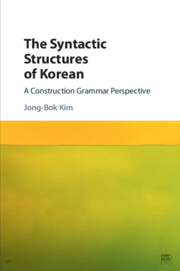Book contents
- Frontmatter
- Contents
- Acknowledgments
- Abbreviations
- 1 Theoretical foundations
- 2 Noun phrases
- 3 Case system
- 4 Auxiliary and complex predicate constructions
- 5 Gerund phrases and mixed categories
- 6 Verbal nouns and light verb constructions
- 7 Serial verb constructions
- 8 Negation and related phenomena
- 9 Coordination
- 10 Passive constructions
- 11 Wh-questions
- 12 Topic and focus constructions
- 13 Relative clause constructions
- 14 Honorification
- References
- Index
3 - Case system
Published online by Cambridge University Press: 05 July 2016
- Frontmatter
- Contents
- Acknowledgments
- Abbreviations
- 1 Theoretical foundations
- 2 Noun phrases
- 3 Case system
- 4 Auxiliary and complex predicate constructions
- 5 Gerund phrases and mixed categories
- 6 Verbal nouns and light verb constructions
- 7 Serial verb constructions
- 8 Negation and related phenomena
- 9 Coordination
- 10 Passive constructions
- 11 Wh-questions
- 12 Topic and focus constructions
- 13 Relative clause constructions
- 14 Honorification
- References
- Index
Summary
In a free-word-order language like Korean, case markings play a central role in licensing arguments, signaling grammatical functions, and even marking information structure. The case system in Korean displays further intriguing patterns concerning phenomena such as free and forced case alternations, case assignment on non-nominal (adverbial as well as verbal) elements, and so forth. Such a complex array of case patterns has cast theoretical as well as computational challenges. Departing from the previous configurationbased or lexicalist approaches, this chapter tries to provide a treatment of case assignment patterns in Korean within a construction-based HPSG perspective.
Two basic issues
Nominal expressions in Korean can carry case markers. Depending on the relationship that these case markers express, cases can be generally divided into two groups: grammatical case markers and semantic case markers. The examples in (1) are some canonical examples:
(1) a. haksayng-tul-i chayk-ul ilk-ess-ta
student-PL-NOM book-ACC read-PST-DECL
‘The students read a book.’
b. totwuk-tul-i pomwul-ul sangca-ey swumky-ess-ta
thief-PL-NOM treasure-ACC box-LOC hide-PST-DECL
‘The thieves hid a treasure in the box.’
The nominative (NOM) and accusative (ACC) grammatical cases here indicate syntactic functions such as subject and object. The grammatical cases NOM and ACC are assigned by a verbal expression like manna- ‘meet’ in (2a), whereas the genitive (GEN) case is licensed by a nominal expression, as seen from (2b):
(2) a. Mimi-ka/*uy chinkwu-lul/*-uy manna-ss-ta
Mimi-NOM/*GEN friend-ACC/*GEN meet-PST-DECL
‘Mimi met a friend.’
b. Mimi-uy/*i chinkwu
Mimi-GEN/*NOM friend
‘Mimi's friend’
Meanwhile, a semantic case like locative (LOC) in (1b) expresses the semantic function of the NP sangca ‘box’. Other semantic cases, closely related to the semantic role of the nominal in question, include goal (GOAL), instrument (INST), source (SRC), comitative (COMIT), and the like, as illustrated in the following:
(3) a. haksayng-tul-i pesu-lo hakkyo-ey ka-ss-ta
student-PL-NOM bus-INST school-GOAL go-PST-DECL
‘Students went to the school by bus.’
b. haksayng-tul-i chinkwu-tul-kwa nol-ass-ta
student-PL-NOM friend-PL-COMIT play-PST-DECL
‘Students played with friends.’
Given these two types of case markings, we could then classify case values as in the following hierarchy:
The hierarchy tells us that case markings in Korean are first classified into two subgroups: gcase (grammatical or structural case) and scase (semantic case).
- Type
- Chapter
- Information
- The Syntactic Structures of KoreanA Construction Grammar Perspective, pp. 47 - 83Publisher: Cambridge University PressPrint publication year: 2016



